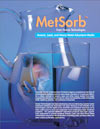MetSorb HMRG Arsenic & Heavy Metal Reduction Media

Graver Technologies MetSorb HMRG 16/60 |
List Price: US$428.00 Starting at: US$342.50 Choose Option: In order to reduce shipping costs media orders may be split into multiple boxes and ship in clear plastic bags instead of the original packaging. Bulk quantity discounts available. For bulk quantities, please call 1-866-376-2690 for price quote.
Found a Lower Price? Request a Price Beat |
highly effective adsorption media for the removal of trivalent and pentavalent arsenic and a wide range of heavy metals
MetSorb HMRG 16/60 is a patented titanium dioxide (TiO2) based granular adsorbent media used to remove arsenic III & V (trivalent and pentavalent, respectively), and a wide variety of heavy metals including Lead, Cadmium, Copper, Chromium+6, Selenium, and Zinc from drinking water. It is also frequently used to remove uranium.
- top-performing arsenic removal media
- removes both trivalent and pentavalent arsenic as well as a wide range of heavy metals
- spent media meets requirements for non-hazardous landfill disposal
- minimal backwash requirements reduces water waste
- will not "dump" arsenic upon media exhaustion
- does not require chemical regeneration
- low cost per gallon treated - long media life in most applications
- less affected by competing ions than competitive technologies
- made in the U.S.A.
Independent testing consistently ranks MetSorb as a leading media for the removal of arsenic. It has a higher capacity and a lower level of ion interference than competitive iron and alumina based media. MetSorb's extremely fast kinetics allow highly effective removal with contact times of only 1.5 to 3 minutes.
MetSorb is applied in water treatment applications varying in scale from small residential systems to large-scale municipal water treatment plants.
MetSorb systems are typically run in downflow configuration with a periodic backwash to reduce the risk of channelling and to remove any particulate trapped in the filter bed. Pre-filtration for particulates can reduce frequency of backwash needed. Treatment systems can be configured as single-tank systems or as multi-tank systems in parallel for higher flow rates or in series flow for applications with high influent arsenic concentrations (generally recommended where the arsenic levels exceed 60 ppb). An empty-bed contact time (EBCT) of 3 minutes is recommended for challenging water qualities.
MetSorb HMRG has been evaluated using both the EPA TCLP (CFR 40-RCRA Regs.) and California WET methods and has been found to be non-hazardous and safe for landfill disposal. Since each application differs, however, Graver Technologies and HomePlus Products recommend that exhausted MetSorb HMRG be evaluated following all federal, state, and local regulations regarding necessary approvals for landfill disposal.
We strongly recommend ongoing water testing to monitor for arsenic breakthrough and to assess media life and schedule for media replacement.
| Operating Conditions / Requirements: | |||||||
|---|---|---|---|---|---|---|---|
| Service Flow Rate: | 8-10 GPM/ft2 | ||||||
| Flow Direction: | Downward Flow | ||||||
| Empty Bed Contact Time (EBCT): | 1.5-3 Minutes | ||||||
| Typical Pressure Drop: | <5 psi | ||||||
| Backwash Flow Rate: | 8-10 GPM/ft2 | ||||||
| Backwash Flow Volumes: | 5-7 Bed Volumes | ||||||
| Typical Freeboard: | 35-40% | ||||||
| Minimum Bed Depth: | 24 Inches | ||||||
| Recommended Bed Depth: | 30 Inches | ||||||
| Maximum Feed Temperature: | 150F | ||||||
| Maximum Recommended pH: | 8.3 | ||||||
| Weight: | 40 lbs per Ft3 | ||||||

Elevated levels of iron and manganese will reduce media life. It is recommended that iron and manganese be treated to reduce influent levels to 0.30 ppm (mg/l) and 0.05 ppm (mg/l), respectively prior to MetSorb. High free silica levels may impact media life in certain circumstances - please contact one of our certified water treatment technicians for assistance if your water supply has more than 30 ppm (mg/l) of free silica or more than 15 ppm (mg/l) of silicon. pH should be reduced to less than 8.3. If hydrogen sulfide (rotten egg odor) is present, please contact us for advice before applying MetSorb as additional pre-treatment will be required. Conversion of trivalent arsenic to pentavalanet arsenic prior to treatment with MetSorb is not required, however, it will enhance MetSorb performance. We recommend Filox media for the pre-treatment of iron, manganese and hydrogen sulfide, and to convert trivalanet arsenic to pentavalent arsenic.
| Recommended Configurations for Residential and Light Commercial Applications | |||||||
|---|---|---|---|---|---|---|---|
| Tank Size: |
8 x 44 | 9 x 48 | 10 x 54 | 12 x 52 | 13 x 54 | 14 x 65 | 16 x 65 |
| MetSorb Volume (Cubic Feet): |
0.75 | 1.0 | 1.5 | 2.0 | 2.5 | 3.0 | 3.5 |
| Bed Depth (Inches): |
25 | 27 | 33 | 30 | 32 | 33 | 30 |
| Rec. Service Flow Rate (GPM): |
2.8 | 3.5 | 4.4 | 6.3 | 7.4 | 8.6 | 11.2 |
| Maximum Rec. Flow Rate (GPM): |
3.5 | 4.4 | 5.5 | 7.9 | 9.2 | 10.7 | 14.0 |
| Backwash Flow Rate @ 40F (GPM): |
3.0 | 3.5 | 4.5 | 7.0 | 8.0 | 9.0 | 12.0 |
| Backwash Flow Rate @ 70F (GPM): |
3.5 | 4.5 | 6.0 | 8.0 | 9.0 | 10.0 | 15.0 |




 (2)
(2)


